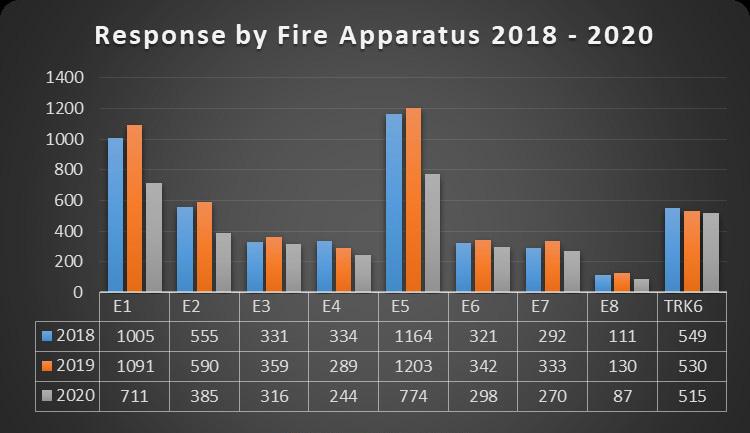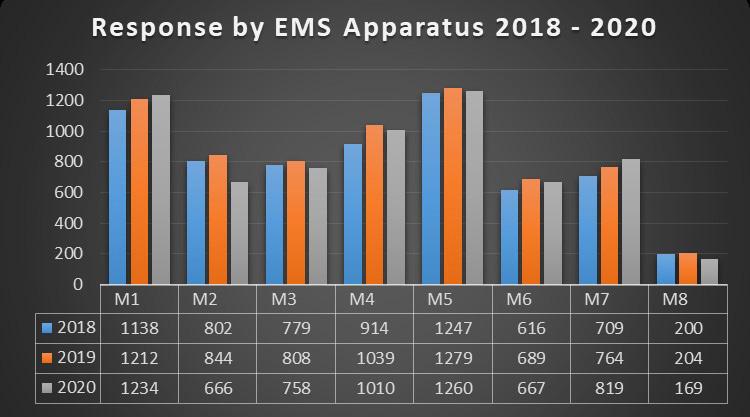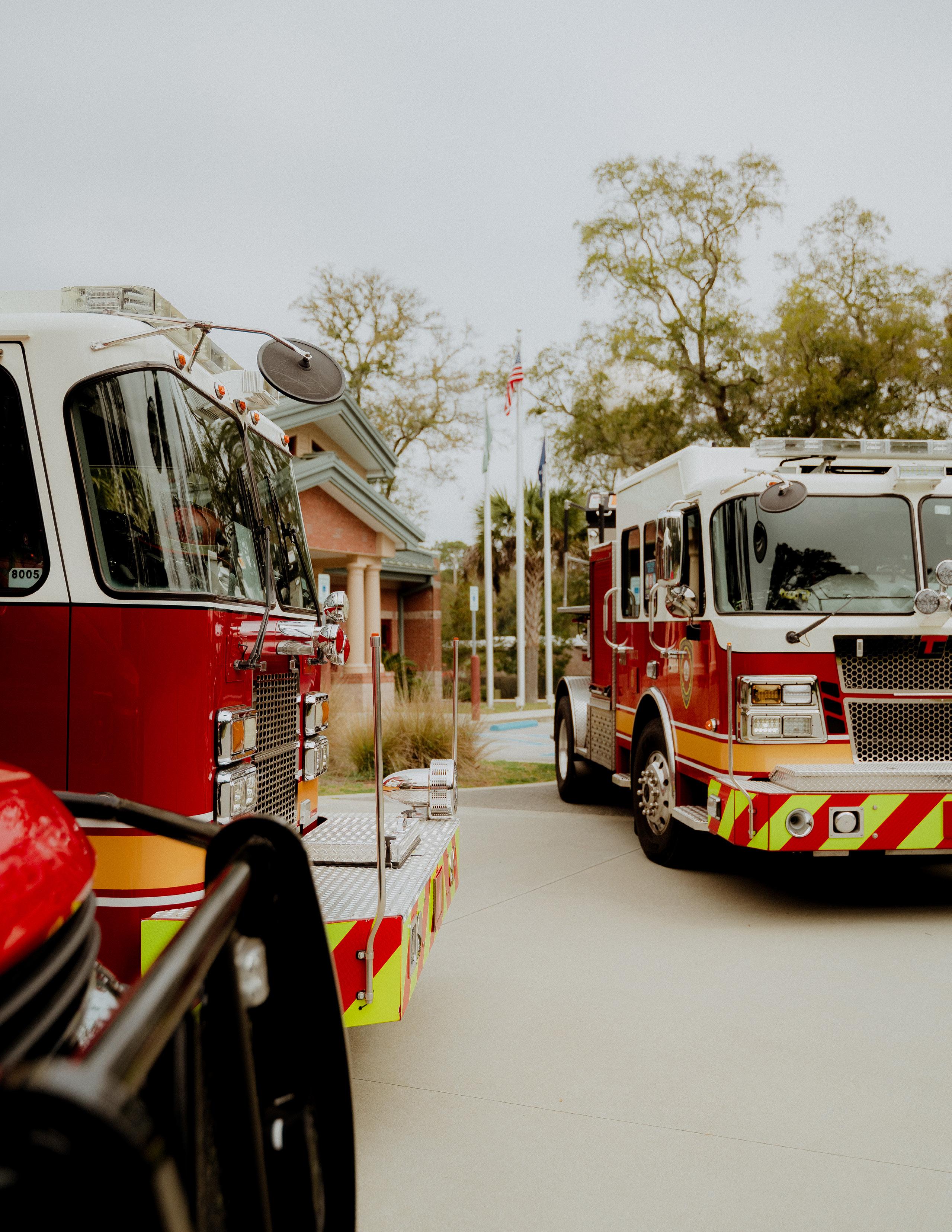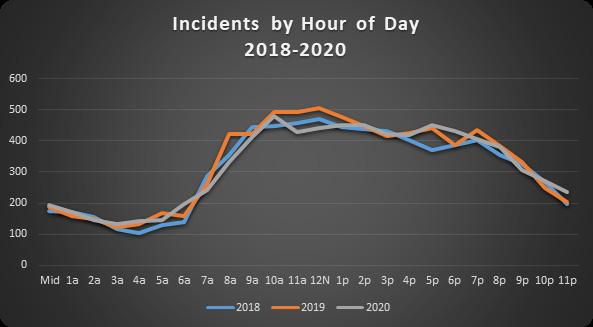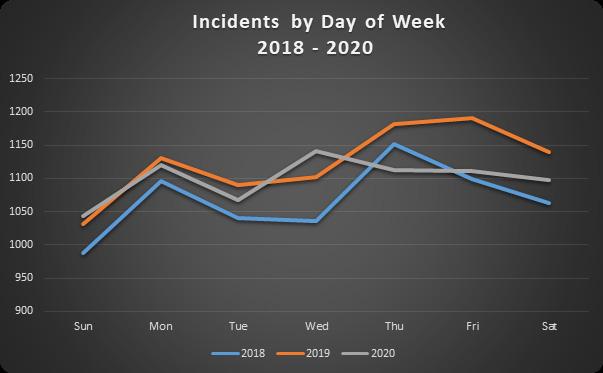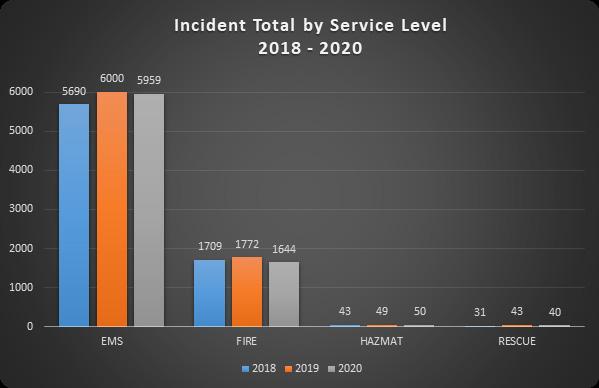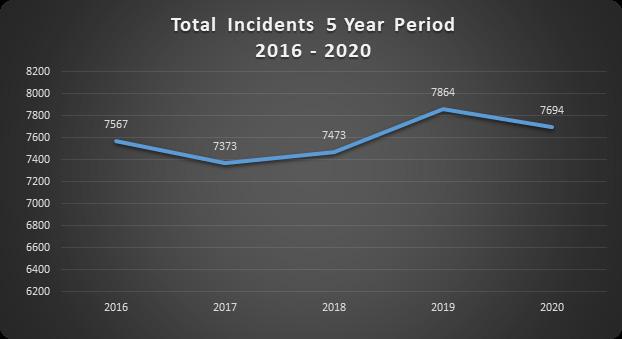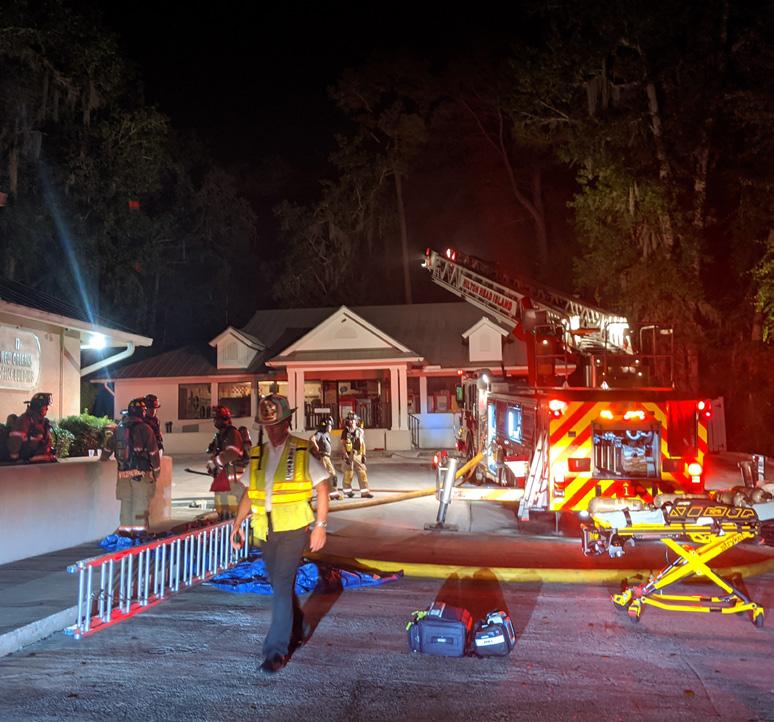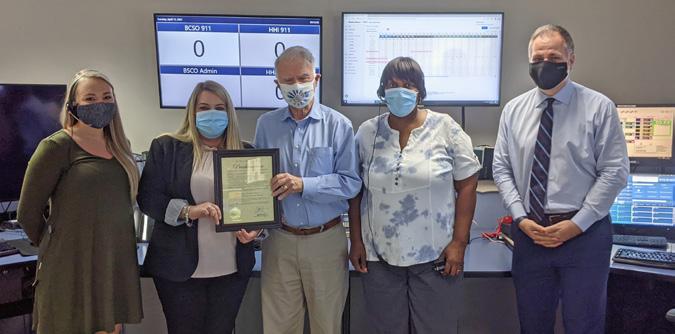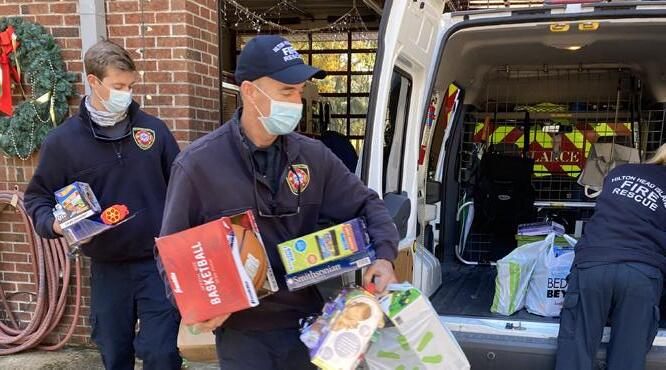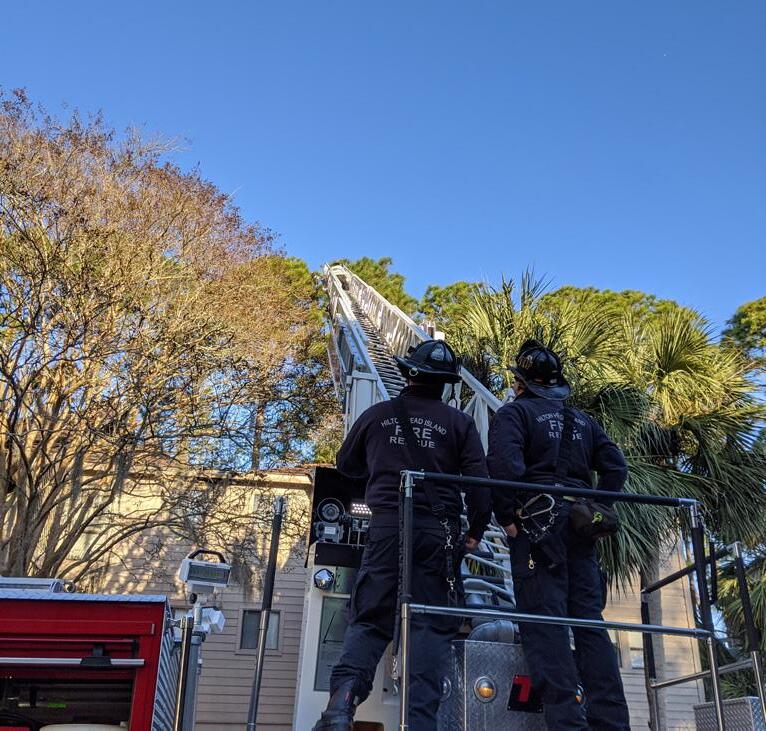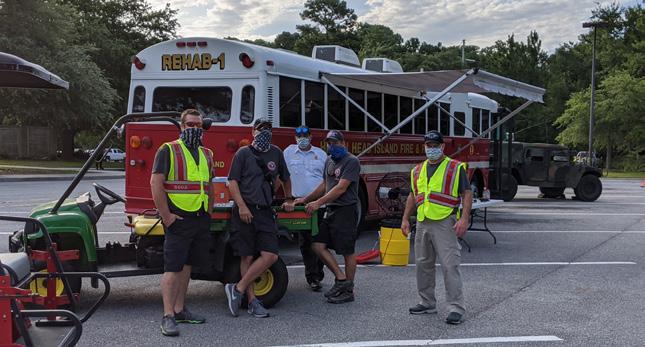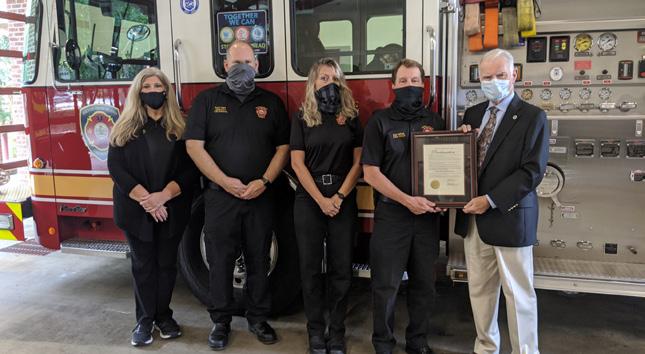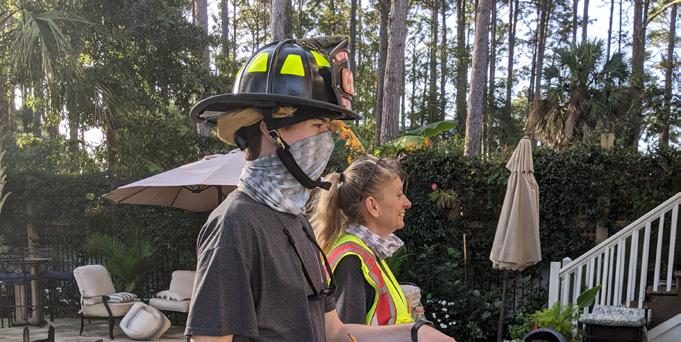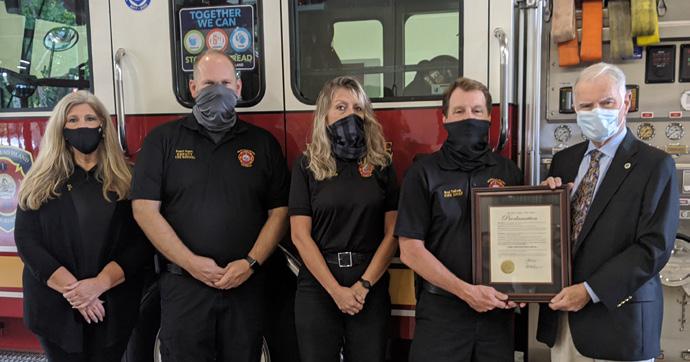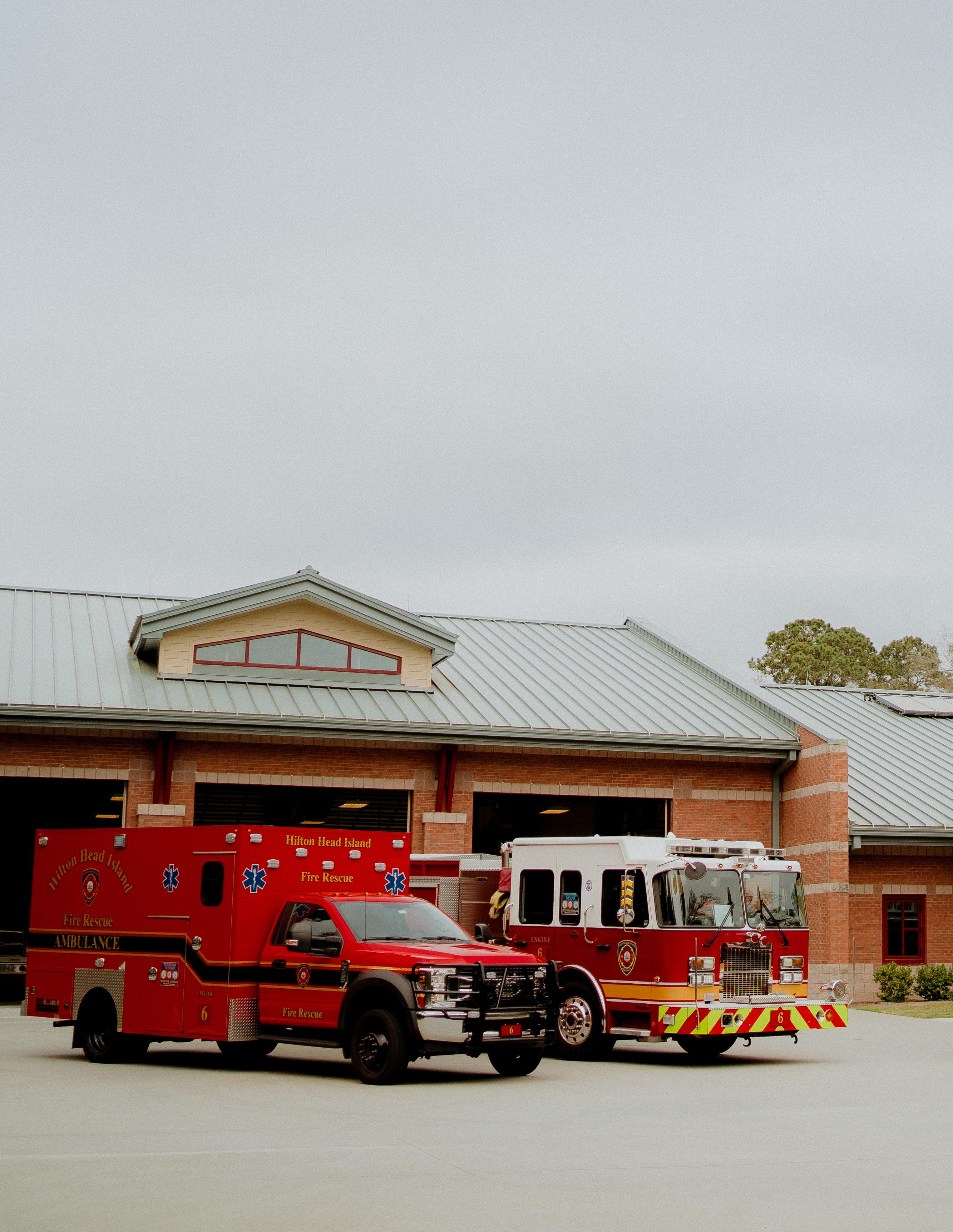HILTON HEAD ISLAND FIRE RESCUE







To Strive for Excellence in all that we do!
Hilton Head Island Fire Rescue is committed to serving our citizens and visitors by preserving life, protecting property, and conserving the environment.

Hilton Head Island Fire Rescue Core Values are to serve our community through:
G Compassion
G Integrity
G Professionalism
G Diversity
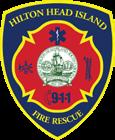
I am pleased to present the Hilton Head Island Fire Rescue 2020 Annual Report.
The past year was certainly challenging for Fire Rescue as it was for our entire community. I am extremely proud of our team and how we navigated the complex issues in providing emergency response during the pandemic. Our focus was keeping our members safe so we could maintain our operational capabilities. The team went to work to identify and implement processes to protect our people, facilities, and equipment. The processes were reviewed and updated as needed. Our team faced a tremendous amount of
stress and they overcame and adapted as true professionals do in trying times.
I am also honored this year to include comments recognizing retired Town Manager Steve Riley. Steve provided great support to Fire Rescue over the years.
As always I extend a thank you to the community, Town Council, and Town Staff for their support of Fire Rescue.
Please contact any member of the Fire Rescue staff if you have questions or need information. We are here to serve.
Long time Town Manager Steve Riley was presented a Fire Rescue white helmet, signifying his leadership position and honorary membership in the department as part of his retirement on Dec. 31st, 2020.

Steve joined the Town of Hilton Head Island in 1991 and became Town Manager in 1994. Steve was the only Town Manager Fire Rescue had ever really known since the Town took over responsibility for emergency services in 1993. As the Town Leader, he set high standards for customer service and supported the department’s development as a high performing and nationally recognized organization.

Steve was also recognized with the department’s 2020 Fire Chief’s Award. This award is presented by the Fire Chief
and Deputy Fire Chiefs to an individual for outstanding performance or achievement in support of the mission of Fire Rescue.
Steve has provided excellent leadership and

guidance over many years and we extend a heartfelt thank you.
We wish Steve and his family all the best in retirement!
Zachary Basar Firefighter
Brock McDaniel Firefighter
Patrick Clendinning Firefighter
Spencer Edwards Firefighter
Maxwell Peterson Firefighter

Derek Kohler Firefighter
Michael Manning Firefighter
Tristan Galm Firefighter
Abel Haro Firefighter
Russell Rogers Deputy Fire Marshal
Peter Maresma Firefighter
Becky Neugent E911 Comm. Manager
Cody Wennerstrom Firefighter
Tamara Ruban E911 Dispatcher
Joe Zoffoli
Derek Mumford
Aaron Aumick
Ryan Hardy
Josh Daugherty
Tim Huser
Sean Kavlick
Orlando Marrero
Michael Sarracino
Missy Thompson
Lieutenant Apparatus Operator Apparatus Operator Apparatus Operator Apparatus Operator Apparatus Operator Apparatus Operator Apparatus Operator Apparatus Operator Dispatch Supervisor
Celebrating 1 Year
Sean Buchanan
Luke Smith
Nicholas Putskey
Adam Rocafort
Trenton Horry
Michael McCullion
Mark Tilley
David Turner
Christopher Osterman
Kayla Roberts
Connor Mayes
Amber Finnin
Celebrating 5 Years
Matthew Emison
Heath Montag
Kyle Schwable
Ashley McDonald
Andrew Groff
Sean Kavlick
Joshua Daugherty
Celebrating 10 Years
Stephen Ralston
Bryan Scharver
Marie Becvar
Spencer Kurtz
Adam Frink
Gabriel Yacso
Timothy Huser
Coulter Bergmann
Erich Lindemann Sr. Dispatcher Apparatus Operator
Celebrating 15 Years
Colin Fanning
James Bell
Celebrating 20 Years
Timothy Olander
Jason Walters
Steven Fierro
Celebrating 30 Years
Raymond Raffaele
Thomas Lowther

Fire Rescue operates seven fire stations strategically located throughout Hilton Head Island to ensure timely and efficient response to emergencies.

In addition to the fire stations, Fire Rescue operates the Fire Rescue Headquarters and Training Facility on Town owned land near the recycle center and Hilton Head Island Airport. The E911 Communications Center is located in a leased facility at the Hilton Head PSD 1 building off of Mathews Drive.
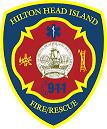
40 Summit Drive – Near Hilton Head Island Airport / Recycle Center
Fire Rescue Headquarters is located off Dillon Road near the Recycling Center. All the Administrative staff as well as the department’s maintenance facility are housed at this location. The building was dedicated in 2001.


21 Oak Park Drive – Near Port Royal Plaza
Fire Rescue operates an E-911 Communications Center located in the Hilton Head Public Service District Office Building off Mathews Drive. The center handles all 911 calls originating on Hilton Head Island and Daufuskie Island. The center also serves as a backup facility to the Beaufort County Dispatch center.

75 Dillon Road
Fire Rescue operates a training facility near the Fire Rescue Headquarters. The facility provides props and equipment necessary for the development of personnel. The center allows for various training scenarios, including live fire operations, vehicle extrication, pumper and water supply practice, and driving skills. The three- person Coverage Crew’s engine and medic units are housed at the training facility as well. The facility was dedicated in 2009.
70 Cordillo Parkway – Shipyard Plantation
Fire Rescue Station 1 is located just inside the Pope Avenue Security gate at Shipyard Plantation. The station was dedicated in November 2011.

Station 1 apparatus include:
One 103’ Quint • One Medic • Urban Search and Rescue unit
Full staffing at this station is one company officer and four firefighters per shift.

Fire Rescue Station 2
65 Lighthouse Road – Sea Pines Plantation near Plantation Center and is the oldest operating fire house. Fire Station 2 was dedicated in 1975 and will be replaced with a new design in 2020/2021.

Station 2 apparatus include: One Engine • One Medic
Full staffing at this station is one company officer and three firefighters per shift.
Fire Rescue Station 4
400 Squire Pope Road – located near the Cypress Gate at Hilton Head Plantation. Station 4 opened in 2005.

Station 4 apparatus include: One Engine • One Medic • Reserve Engine & Medic
Full staffing at this station is one company officer and three firefighters per shift.
Fire Rescue Station 3
534 William Hilton Parkway – located mid-island near the First Presbyterian Church and Port Royal Plantation. Station 3 opened in 2000.


Station 3 apparatus include: One Engine • One Medic • Brush Unit and Utility /Air Supply unit
Full staffing at this station is one company officer and three firefighters per shift.
Fire Rescue Station 5
20 Whooping Crane Way - located near the main entrance to Hilton Head Plantation and opened in 2011.
Station 5 apparatus include: One 103’ Quint • One Medic • Reserve Ladder Truck
Full staffing at this station is one company officer and four firefighters per shift.






Fire Rescue Station 6
12 Dalmatian Lane – Palmetto Dunes Resort

This station opened in 2014.
Station 6 apparatus include: One 110’ aerial TDA • One Engine • One Medic unit • Hazardous Materials Response unit
Full staffing at this station is two company officers and six firefighters per shift.
Fire Rescue Station 7

1001 Marshland Road – Near Cross Island Toll Plaza
This station was dedicated in 2003. The Battalion Chief supervising the shift is located at this station.
Station 7 apparatus include: One Command Vehicle • One Engine • One Medic • Reserve Engine • Reserve Medic

Full staffing at this station is one Battalion Chief, one company officer, and three firefighters per shift.

Station
Station







Hilton Head Island Fire Rescue emergency vehicle fleet consists of eight Fire Engines (Pumpers), two Aerials (Quints), two TractorDrawn Aerials (TDAs) and ten Ambulances (Medics). Fire Rescue also has special use vehicles that support emergency responses. Standardizing our fleet provides an efficient delivery of services to the community and reduces maintenance costs.

Fire Rescue’s Fire Engines (Pumpers) provide up to 1500 gallons of water per minute (GPM). Pumpers are housed in five of the seven fire stations; two operate as reserves, and one is staffed by the Coverage Crew.
Two Aerials (Quints) are located at Fire Stations 1 & 5. The Quint designation refers to the five components of the apparatus: a fire pump, water tank, fire hose, aerial ladder, and a specified number of ground ladders. The versatility of a quint is that it is capable of operating as an engine or as an aerial ladder truck using the 103-foot ladder.
A specialized ladder truck, known as a Tractor-Drawn Aerial (TDA) or “tiller truck”, is housed at Fire Station 6 in Palmetto Dunes. With drivers at each end, the TDA is highly maneuverable, which is important for navigating Hilton Head Island’s tight road network.

Fire Rescue operates one tractor-drawn aerial ladder and has one reserve apparatus.

Fire Rescue’s medic units (ambulances) are a standardized fleet of advanced life support vehicles. All stations have a medic unit assigned with the engine company. Two additional medic units are in reserve and one is operated by the Coverage Crew. All 10 ambulances were replaced with a new model in 2019.

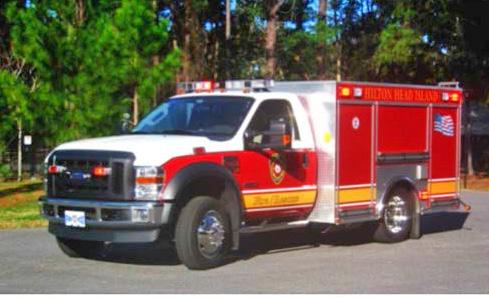

Fire Rescue operates other specialty Apparatus:
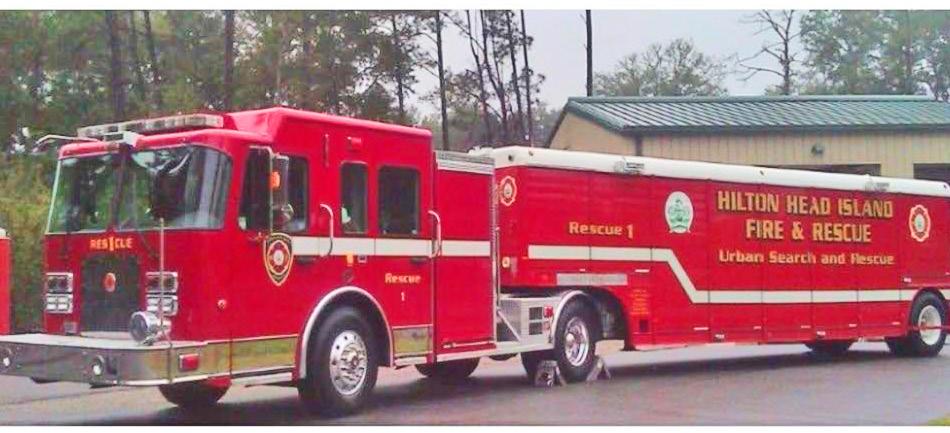
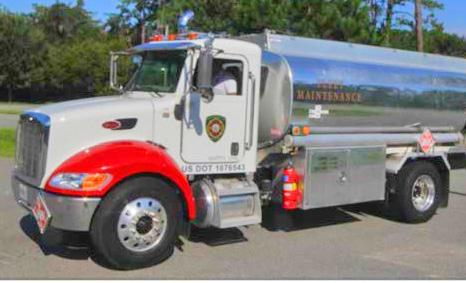
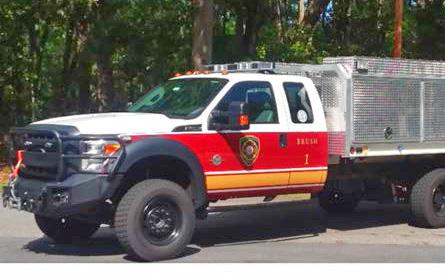


OPERATIONS COMMAND VEHICLE – BATTALION 1
HAZARDOUS MATERIALS RESPONSE APPARATUS
URBAN SEARCH AND RESCUE APPARATUS

Deputy Fire Chief Chris Blankenship provides executive leadership to the Fire Rescue Operations Division. Fire Operations is the largest division of Fire Rescue and is comprised of Line Personnel, Safety & Professional Development, and the Emergency Medical Services Division (EMS).

Line Operations is comprised of 3 shifts working a 24 hour on /48 hour off shift schedule. Each shift is led by a Battalion Chief with 35 members assigned to each of the three shifts for a total of 105 line personnel. The minimum daily staffing level is 29. A three member team, the Coverage Crew, also supplements staffing during daytime hours when call volume is at its peak.


All line personnel are cross-trained in both firefighting and EMS. We respond to all types of calls for service; fires, medical emergencies, motor vehicle collisions, hazardous materials spills, and specialized rescues. The members are required to participate in extensive year round training activities to maintain and improve their skills.
The ability to improve our service is generated through many initiatives that originate from our members. Their values, energy, commitment, and compassion drive many of Fire Rescue’s functions, programs, and services throughout the year. The Operations Division personnel are the men and women you see every day out in the community accomplishing the department’s mission to provide extraordinary service to the community.
• 7,694 - Total calls for service
• 5,312 - EMS Calls
• 2,382 - Fire/Service Calls
• 366 - Open burning compliance checks
• 3,000+ - Hydrant Inspections
• 39,600 feet - Total Fire Hose Tested


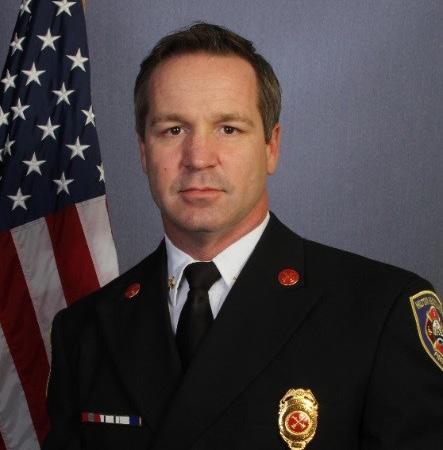
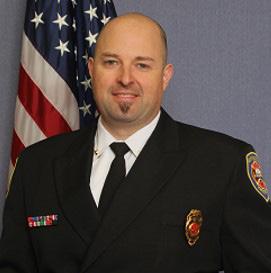

Hilton Head Island Fire Rescue has two Special Operations Teams - South Carolina Task Force 4 (SCTF-4) and South Carolina Hazardous Materials Emergency Response Team 4 (SCHM-4). These teams are comprised of firefighters from Hilton Head Island Fire Rescue and Bluffton Township Fire District. The teams are ready to respond to significant technical rescue and hazardous materials emergencies locally, regionally, and statewide.

The Technical Rescue Team (SCTF-4) provides rescue, recovery, and disaster assistance at various types of incidents. These incidents may involve collapsed buildings, trench collapse, confined space rescue, high angle rescue, heavy vehicle or machinery entrapment, large area search, and flood water evacuation and rescue.



As part of the State of SC Emergency Response Task Force, the team serves as one of five SC Regional Urban Search & Rescue Response Teams and is subject to deployment anywhere in the state through Firefighter Mobilization.
The team is comprised of fifty firefighters from Hilton Head Island Fire Rescue and Bluffton Township Fire District and is available for emergency responses within both jurisdictions on an around the clock basis, every day of the year. Additionally, the team provides technical rescue response to the City of Hardeeville, the Town of Ridgeland, and Jasper County through mutual aid agreements.
In 2020 there were thirteen incidents in which the team participated as a partial or full team response.

Ten monthly training sessions were conducted which included skills development and disaster scenarios. Several members attended specialty training and twenty members obtained swift water technician certification in Rock Hill, SC. Sixteen members also completed a floodwater boat operations class in June.

The team participated in a statewide multi-agency rescue drill in Columbia in March. A full team was deployed and operated for several hours in a simulated collapsed building. This was the team’s required annual performance evaluation conducted by the South Carolina Law Enforcement Division.

In 2020, using Department of Homeland Security funding, the team designed and purchased a regional floodwater response trailer. This trailer transports two boats with additional dry storage area for personal protective and water rescue equipment. The trailer has a built-in decontamination system, lighting, and generator for self-sustained operations

The Hazardous Materials Emergency Response Team (SCHM-4) responds to emergency calls involving the release of hazardous materials or to test chemicals to determine the risk posed to the community. The purpose of SCHM-4 is to provide victim removal from hazardous atmospheres, decontamination of individuals exposed to contaminants, and incident stabilization/property (environmental) conservation through hazardous materials identification and release mitigation. The Team also serves as a Regional Hazmat and Weapons of Mass Destruction (WMD) response asset for the State of South Carolina and is subject to deployment anywhere in the state through Firefighter Mobilization.
The Team is comprised of firefighters from Hilton Head Island Fire Rescue and Bluffton Township Fire District. SCHM-4 provides hazardous materials response coverage to the City of Hardeeville, the Town of Ridgeland, and Jasper County through mutual aid agreements.
Team members attend monthly training while on duty and off duty throughout the year. The topics also ensure team members meet national standards.
The SCHM-4 also participates in operational readiness exercises that are developed and administered by the State to evaluate the team’s performance. In early 2020, SCHM-4 traveled to Columbia, SC for a simulated mass casualty decontamination event, and was assigned to work alongside a team from Rock Hill, SC. This was beneficial as it allowed personnel to experience and understand different mitigation strategies and to function inside the complex framework of a large incident.

SCHM-4 constantly strives to stay up to date with new detection technologies that are available for hazardous material mitigation. This year saw the replacement of outdated air monitoring equipment and the addition of new laptop computers used during incident management.



In 2020 Fire Rescue like the rest of the world was impacted by the global pandemic known as COVID-19. Fire Rescue adapted our procedures in areas such as call processing, response, and personal protective equipment (PPE). The changes made early in the pandemic were crucial to keeping our staff and those we serve safe. These changes were effective and have continued to carry us through this pandemic. At no time was staffing or response in jeopardy in 2020. Below is an example of our COVID-19 PPE guidance.


The COVID-19 pandemic placed EMS operations into a defensive posture for the majority of 2020. Our policies and procedures had to adapt so that we could continue to provide clinically excellent care in a manner that kept our EMTs and paramedics safe.



These adaptations included:
• Continuing education for Fire Rescue staff on emerging infectious diseases including the role of vaccination
• Employee screening including temperature checks to identify presymptomatic cases
• Additional patient screening questions in our 9-1-1 communications center
• Different levels of personal protective equipment depending on call type
• Donning and doffing procedures to minimize risk of infection
• Decontamination of equipment, ambulances, fire stations, and personnel
• Tracking of aerosolized procedures and exposures
• Quarantine, isolation, testing, and return-to-work protocols
• Creating a 30-hour online EMT and Paramedic Refresher program so that staff can re-certify remotely
• Supporting community COVID testing at Hilton Head Hospital
• Partnering with Hilton Head Hospital to ensure EMTs and paramedics were included in Phase 1A of the vaccine rollout
These procedures were developed in partnership with high performing EMS systems in the United States including our
friends from the Seattle / King County Resuscitation Academy. They were reviewed by an epidemiologist who determined that we were operating at the highest possible standard to keep our employees and our community safe.
We are extremely proud of the men and women of Hilton Head Island Fire Rescue who continue to serve our citizens and visitors during this uncertain time with courage, compassion, and commitment.
With so much attention on the global pandemic it’s easy to forget that we are also dealing with a concurrent opioid epidemic. More than 40 states have reported an increase in overdose deaths, mostly driven by illicitly manufactured fentanyl, along with ongoing concerns related to mental illness and substance use disorder.
Locally, after 2 consecutive years of decline, we saw an increase in the number of times our paramedics administered the drug naloxone.

To help address this issue the U.S. Substance Abuse and Mental Health Services Administration and U.S. Drug Enforcement Administration have provided increased flexibility for providing buprenorphine and methadone to patients with opioid use disorder following a telephone evaluation.
There is no magic bullet but Fire Rescue will continue to work with community partners and, when possible, connect patients with available health resources.
After identifying a 5-fold increase in the number of interfacility transports (hospital to hospital) from 2015 to 2019 the Leadership Team at Fire Rescue reached out to Hilton Head Hospital to express our concerns related to the high acuity level of some of these patients, the amount of time our front line ambulances are spending off the island, and the fact that these transports often have the effect of shutting down an engine company for several hours.

Hilton Head Hospital has been receptive to these concerns and we are formalizing a memorandum of understanding between the two organizations to help clarify expectations related to the use of private ambulance companies when appropriate and minimize patient safety events by ensuring the appropriate level of critical care for select patients when indicated.

This division is led by Battalion Chief Colin Fanning and is charged with managing the department’s overall safety and risk management programs, personnel development and industry-standard fire training functions. Safety & Professional Development includes an operations engine company, a staff captain, and the Battalion Chief. Training, a component of professional development, is conducted with the help of 20 instructors from the ranks of firefighters.

Engine Company # 8, known as the Coverage Company, reports to the Safety & Professional Development Division and is housed at the Training Center. This crew cross-staffs a fire engine and ambulance with a 3-person crew consisting of a Company Officer, Fire Apparatus Operator and a firefighter paramedic. The company works a 40-hour week during the busiest daytime hours of 7:00 am-5:00 pm. In addition, the Coverage Company coordinates and provides new firefighter orientation training which is completed before the new firefighters report to their assigned shift.
In late February, Fire Rescue converted from normal operations into a pandemic emergency management operation. Safety and Professional Development assumed the function of the Planning Section throughout the weeks of emergency operations and developed new policy and procedures, guidance documents, training guides, and other operational support. The divisional staff, with the help of line firefighters, turned out five operational guides, nearly 40 training guides, documented 50 standing orders and 22 planning bulletins over the nine weeks of emergency operating periods. The division also assisted Emergency Management in the transition from operations to recovery.
• Developed 192-hour Driver Operator Academy
• Conducted initial 160-hour driver / operator training program
• Transitioned from operations support to pandemic emergency planning

• Completed the on-boarding and orientation for 7 new firefighters
• Completed a Fire Apparatus Operator promotional process
• Upgraded the training facility utilities and security
• Total Hours – 32,815
• Fire Company Hours – 15,095
• Officer Development Hours – 1,453
• Driver/Operator Hours – 2,860
• 39,600 feet - Total Fire Hose Tested
Fire Rescue’s training program is developed in accordance with established federal, state, and local requirements as well as the ISO Fire Suppression Rating Schedule and National Fire Protection Association.
The pie chart below identifies the training disciplines which are covered in our training program. The cumulative training hours and percentage of the overall training hours (32,815) are depicted within the chart. Analyzing this information allows administrators to determine if the division is providing the correct amount of time

in each of these disciplines. It also provides company officers with a big picture view of where and what they have been training on throughout the year.
The team works with other divisions within the Town to maintain individual safety training as required by the Occupational Safety and Health Association (OSHA). The division manages all types of risks that emergency services organizations will typically face. The Battalion Chief is a standing member of the Town’s Safety Committee and the direct liaison to the Fire Chief regarding safety concerns for Fire Rescue.

Deputy Chief / Fire Marshal Joheida Fister provides the executive leadership of the Administration Division. The division includes the Bureau of Fire Prevention, the E911 Communications Center, E911 Addressing and the Supply and Support Divisions. The Administration Division also serves as the liaison between Public Safety Systems (IT) and Fire Rescue.

The Administration Division performs risk reduction activities, technical analysis, administrative support, and manages the supply tasks necessary for the smooth functioning of the entire department. Deputy Chief Fister also serves as the Public Information Officer and is responsible for the fire records management systems, emergency response data, and our national accreditation compliance.

The Bureau of Fire Prevention is led by Battalion Chief Russell Rogers and works every day to ensure that our communities risk is as low as possible. Town of Hilton Island Fire Rescue focuses on three main community risk reduction objectives; code enforcement/ fire inspections, public Fire and Life Safety education, and fire origin and cause investigations. The personnel within Fire Rescue work to proactively prevent or mitigate the impact of emergency incidents within their community. We work with strategic partners, community groups, and state resources to reduce preventable deaths, injuries and property loss through education, enforcement, and engineering. Just as everyone else has made adjustments, we have had to adapt our programs to meet the needs associated with the risk of COVID-19. We have done virtual classroom visits, virtual CPR skills evaluations and outdoor scavenger hunts to keep the community engaged in our mission to reduce risks and educate the public.


• Administration of the international Fire Code
• Installation of life safety systems in buildings
• Presenting fire and life safety education initiatives and programs
• Conducting fire investigations
• Providing opportunities and interactions with the public on fire and accident prevention programs
• Open Burning Compliance Inspections - Crews conducted 366 open burning compliance checks during the calendar year 2020. (On-going)
• Fire in the Streets - Fire Rescue continued the Fire in the Streets program. This program focuses on a specific residential area of the community with Fire Rescue personnel going door to door and meeting with the residents. At each home, the personnel check smoke alarms or install new batteries. In conjunction with our existing smoke detector program, Fire Rescue visited 116 homes, installed 98 smoke alarms and changed 15 batteries in 2020. Since the inception of the Fire in the Streets Program the department has visited over 973 homes and installed 1400 smoke alarms and changed 554 batteries. (Ongoing)
• Facebook Posts – Fire Rescue has begun posting weekly safety and promotional messages on Facebook. These messages include services offered by Fire Rescue, safety messages, and items of interest about Fire Rescue. This number does not include posts during disasters. (Ongoing)

• Hydrants - Fire Rescue in cooperation with HHI PSD identified areas where hydrant locations exceed the International Fire Code requirements. A cost sharing agreement was executed and 10 new hydrants have been installed and 4 more are still planned. (Since 2017)
• Santa Mail - The Santa Mail program starts the day after Thanksgiving and runs until December 24. In 2020 Fire Rescue responded to over 224 letters!
• Geocaching - Hilton Head Island Fire Rescue started Geocaching in 2017 as another method to reach the citizens and visitors with safety messages. Geocaching is a recreational activity – a real world outdoor treasure hunt for finding a hidden object by means of GPS coordinates posted on a website. We have geocaches currently located at Headquarters (Fire Safety), Station 1 (Bike Safety), Station 4 (Boating Safety), Station 2 (Alligator Safety) (Closed while under construction), Station 6 (Water Safety),
and Station 7 (Smoke Alarms). Since the first one was deployed in December of 2017 there have been 1397 visitor logs to the caches.
• Fire Safe SC Community Designation – SC State Firefighter’s Association, SC State Association of Fire Chiefs and SC Fire Marshal Association recognized 57 fire departments as Fire Safe SC Communities. (July 2020)
• Review and approve the construction plans for new buildings or buildings being renovated.
• Conduct inspections during construction.

• Conduct fire inspections for the approval of new business licenses.
• Perform Monthly night time inspections of public assemblies.
• Ensure timely follow up of complaints/ concerns of the community.
• Verify acceptance testing of all fire life safety systems.
• Ensure fire protection systems in buildings are repaired.
• Oversee the “Click2Enter” ® emergency gate access program.
• Coordinate with the three Public Service Districts to ensure damaged fire hydrants are returned to working order.
• Conduct special event inspections.
• Serve as Child Passenger Safety Technicians and participate in monthly car seat checks.
• Enforce the Town’s Outdoor Burning Ordinance.
• Provide training on the development of emergency procedures and evaluate emergency evacuation procedures.
• Support the Fire & Life Safety Educator’s public presentation programs.


• Coordinating the File of Life® program - a record of health related information for emergency responders typically located on the refrigerator in the home.
• Presenting programs for preschools, civic clubs, retirement centers and employers on a range of topics that include: fire safety, bike safety, water safety, fire safe holidays, smoke alarms, safe driving for the elderly, poison prevention, heat related injuries, threatening weather, car fires, calling 9-1-1 and more.
• Updating the Fire & Life Safety information on Town’s website.
• Educating the public and conducting demonstrations on the benefits of fire sprinkler systems and smoke detectors.
• Coordinating smoke alarm installations and battery replacements.
• Providing a robust schedule of public CPR and First Aid training.
• Coordinating car seat installations.
• Providing public training programs such as fire extinguisher training, safe sitters babysitting course and others.

• Promoting the Keep the Wreath Green holiday season fire safety program.

–
• Delivered 286 Public Education programs
• Conducted 15 CPR, AED, and First Aid classes
• Taught 226 students in CPR, AED, and First Aid
• Taught 108 people Fire Extinguisher Training
• Published 25 Articles
• Installed 27 Car seats
• Installed 90 Smoke detectors
•Distributed 1026 File of Life packets
Fire Rescue is required by state law to investigate all fires and to determine where and how they started. We also learn from the types of fires we have in our community to influence our education and outreach programs.
Fire Rescue’s fire investigation team is comprised of members of the Bureau of Fire Prevention and Fire Rescue line personnel. The unit is supervised by the Fire Marshal and coordinates with the Beaufort County Sheriff’s Office on any fire where the cause of the fire is not considered to be accidental.
Determining the cause and origin of a fire may be as straightforward as a resident reporting that they left a pot on the stove. But sometimes a fire can require a considerable amount of investigation due to significant damage
or a hidden cause. Using proper investigation techniques, preserving the evidence, and photographing the fire scene are all necessary steps to ensure investigations are thorough and professionally completed. Information from the fire investigations is used to identify trends and programs that can reduce the potential for future fires.

24 Fires were investigated by the Fire Investigation Team.
Fire Cause included:
• 15 unintentional fires
• 2 intentional fires
• 4 fires caused by the failure of equipment
• 1 fire caused by an act of nature
• 2 fires had a cause that was undetermined
Fire Rescue is required by state law to investigate all fires and to determine where and how they started.
Becky Neugent joined Fire Rescue as the new E911 Communications Manager in January of 2020.

The Hilton Head Island E911 Communication Center serves as the Primary Public Safety Answering Point (PSAP) for Hilton Head Island and Daufuskie Island and is the backup center for the Beaufort County E911 Dispatch Center. The Center answers all 911 calls originating on Hilton Head Island and Daufuskie Island, 24 hours a day, 365 days a year. The E911 Center receives an average of 154 phone calls a day and dispatches more than 20 Fire and EMS calls daily.
The 911 Communications personnel are the unseen, but extremely important link, in the chain of response to an emergency. When a Dispatcher answers a call in the Communications Center, they become the first, first responder. In addition to trying to determine what type of help is needed, personnel frequently help callers identify their exact location so assistance can be sent to the correct location. This can be a challenge given the number of annual visitors to Hilton Head Island.
> Zoara the comfort dog made her way to the Communications Center and several fire stations to bring a little joy during the holiday season!

Implementation of Motorola Vesta Phone System
Fire Rescue’s 911 Communications Center was part of the County’s installation of a new 911 phone system. The Vesta System streamlines call handling and expedites response (task performance focus). Integrates with our Computer Aided Dispatch, radio, recorder and administrative phone systems. The new phone system will provide a forward migration path to next generation 911.
In past years approximately 20 percent of all 911 emergency calls have been randomly selected and reviewed. However, due to the COVID screening questioning that is currently included in the calltaking process, it has been challenging to review that percentage of calls. We are still diligently improving our processes and continue to work toward providing quality service to all citizens of Hilton Head Island. In 2020 we began working with RQI (Resuscitation Quality
• 70 New Addresses Created
• 30 Addresses Updated
• 376 Business License Address Reviews
• 95% of all calls are answered in 5 seconds or less
• 99% of all calls are answered in 10 seconds or less
• Wire-less call count 25,074
• Wire-line call count 27,491
• Total calls transferred 14,149
Improvement) to continue to improve our Cardiac events and provide Telephone-CPR. The communications Center received the Trailblazer Award for our efforts

Dispatch Center remodel


In the summer of 2020 the Communications Center personnel and equipment were temporarily relocated to the Emergency Operations Centers for 30 days for a remodel. In addition to updating the communications center it allowed Fire Rescue to simulate having to move our center if there was a disaster situation that required us to leave our center for an extended amount of time. The update included new paint, new carpet, new kitchen flooring and a small meeting room that will be utilized during EOC activations and other day-to-day purposes.
E911 Addressing is critical to the E911 Communications System. Fire Rescue is responsible for all addressing and street naming within the Town limits of Hilton Head Island. As part of addressing Fire Rescue coordinates with multiple departments within the Town and many outside agencies to make notifications of new addresses and modifications to existing addresses

Hilton Head Island Fire Rescue uses Rapid SOS, a new 911 wireless call location application. This application is free to public safety agencies. It is currently being used in over 4,800 emergency communication centers in multiple countries, managing over 250 million emergencies annually with data from over 350 million devices.
Uses the actual GPS information of the device to pinpoint the exact location of the caller.
The map shows red pins or “bread crumbs” of the caller in motion as they are walking, riding a bike, driving in a car or in a boat.
The green pin is the actual last known location before the call terminated.
Visitors and residents can be located quickly.
It can be difficult to remember your physical address in the middle of a stressful event..
Major incidents can be easily recognized, such as motor vehicle accidents, large outdoor fires, structure fires, or shootings
The “pin” or location, in most cases, populates on the screen BEFORE the phone ever rings into the 911 center to be answered by the call taker.
Response time to the caller and the emergency is faster.
The accuracy of the caller location will display within so many meters along with the percentage of location accuracy.
A basic map view, satellite view and a Google street view are generated to assist the call taker in locating the caller and to further direct the first responders to the exact location if necessary.



Rapid SOS works with Apple and Android devices by AT&T, Verizon, and T-Mobile. Other carriers may be added in the future.
You can add the following personal information in your device so it can be displayed for the call taker: emergency contacts, blood type, age, height, weight, organ donation and any preexisting medical conditions or allergies.
If you have an Apple device, you will need to go into the Health App on your phone. It is white and has a pink heart in the right corner. Once you add all of your information in the app, you have to agree to share that information with Apple so that the information can be sent to us when or if you should ever have an emergency.
If you have an Android device, you must go to www.emergencyprofile.org and enter your information in that platform. You will need to agree to the terms and agree to share that information.
Call 911 immediately.
If someone else is available, have them retrieve the nearest defibrillator.
Download the PulsePoint AED app and help the first responders find these life-saving devices.
Locate and AED.
Push hard and fast in the center of the chest, at a depth of 2 inches, and at a rate of 100 compressions per minute. Keep pushing until the person starts to breathe, move, or someone with more advanced medical training takes over.
Register the AED using the Pulsepoint AED app

Add a photo of the AED in the context of its surroundings
Learn more at pulsepoint.org

Download PulsePoint and PulsePoint AED

If an adult suddenly collapses and stops breathing normally follow these steps until help arrives.
Citizen Contacts – Limited
Due to COVID-19
• Over 1,675 citizen contacts through presentations, community events, and providing preparedness information.
Distributed 170 Preparedness Packages that included:
• Preparedness Guide
Tom Dunn is the Emergency Manager for the Town of Hilton Head Island. The mission of the Emergency Management Division is to prepare, prevent, plan, respond and recover from all-hazard events through developing, maintaining and implementing the ability to direct, control, manage and coordinate emergency operations in cooperation with local, State and Federal governmental and private sector partners.

The Emergency Management Division works closely with many public and private sector partners to ensure we are able to coordinate our actions and needs during an emergency or disaster. This coordination requires planning and close relationships with local, state, and federal partners. Our most critical partner is the Beaufort County Sheriff’s Office’s Emergency Management Division. Our working relationship assists us in exercise planning, event planning and coordination, acquiring needed resources, and support needed to manage events that impact the Town.

Tropical events are a major concern for the Town. The 2020 Atlantic Hurricane Season was the most active in the history of the Atlantic season with 30 named storms. The Town was very fortunate not to be impacted by a tropical event this year.
While we were spared impacts from a tropical event, we were impacted by COVID-19. Like everyone else, Emergency Management was immersed in the response to COVID-19. The Town Emergency Operations Center opened on March 6 and remained opened through May 11, when operations transitioned to the Town’s Recovery team to facilitate the returning of Town staff. Emergency Management continued to support the recovery team with the development of the weekly Recovery Plan.
The Emergency Management Division has been very active with one or more EOC activations annually beginning in 2016.
• Addressing and Open Burning Information
• Replacing Smoke Alarms
• Town Flood Information and Magnet
• NOAA Weather Information Sheet
• Public Classes Rack Card
• Pulse Point Info Sheet
Distributed Additional Information/Kits
• 1000 Preparedness Guides
• 100 Vehicle Emergency Kits
Attended Public Events
• Presented 6 public presentations to over 215 participants
2016
Tropical Storm
Hermine
EOC activation; Hurricane Matthew EOC activation, community evacuation, and Public Safety Evacuation Point activation.
2017
Hurricane Irma EOC activation; community evacuation; and Public Safety Evacuation Point activation.
2018
Winter Storm
EOC activation; Hurricane Florence - EOC activation and Public Safety Evacuation Point established and Hurricane Michaelpartial EOC activation.
2019
Hurricane Dorian EOC activation, community evacuation, and Public Safety Evacuation Point activation

COVID-19
EOC activation in alternate EOC.
COVID-19 significantly affected Emergency Management’s ability to develop, coordinate and exercise plans. Even with the significant response to the pandemic, Emergency Management was able to accomplish much with the support of other members of Fire Rescue and Town departments including:
• Conducting a Town Continuity of Operations Exercise with a pandemic scenario in February.
• Managing the Emergency Operations Center for three months in response to COVID-19.
- Developed weekly incident action plan that steered the Town’s COVID-19 response.
- Developed a completely new plan for our response to COVID-19 that included use of personal protective equipment, safe management of COVID-19 patients and unique equipment configuration to ensure safety of our personnel.
- Created procedures to ensure our personnel were able to respond to COVID-19 patients.
- Worked tirelessly to find critical resources that were hard to get, such as hand sanitizer, N95 respirators, gloves, cleaning supplies, and surgical gowns.
• Supporting large-scale community testing events.
- Developed the plan for large-scale community-testing events in partnership with Hilton Head Hospital, Beaufort County Sheriff’s Office, Volunteers in Medicine, and the South Carolina Nation Guard. The first event in June tested over 1,800 people for COVID-19. This plan was used as the basis for all of the large testing events and mass vaccination clinics in Beaufort County.
- Supported many other testing events throughout Beaufort County with planning and logistical support.
• Supporting the Fire Rescue mission by responding to emergencies and performing liaison activities with agencies such as the Red Cross.

• Participating in the update of the Beaufort County Hazard Mitigation Program.
• Emergency Management in coordination with Community Development applied for and received the HurricaneStrong designation from the Federal Alliance for Safe Houses.

Keith Tison is the Fleet Maintenance Supervisor and is responsible for maintaining Fire Rescue and Town vehicles. Fleet Maintenance Division consist of a Supervisor, two Mechanics and one Administrative Assistant. The Townwide fleet totals approximately 100 vehicles and includes:


• 20 Fire Rescue staff vehicles
• 30 Fire Trucks / Ambulances
• 27 cars / trucks Town Operations
• 15 cars / trucks Facilities Management
• 39 trailers, various off road vehicles, equipment and mowers
Fleet Maintenance has a comprehensive preventative maintenance program, which includes diagnostics and repairs of all Town Operations vehicles, Fire Rescue staff vehicles, Fire Apparatus, off road vehicles, and all equipment including fixed and mobile generators.

Fleet Maintenance personnel receive significant manufacturer specific training and hold Master Automotive Service Excellence (ASE) and Master Emergency Vehicle Technician (EVT) Certifications. This training allows staff to perform most functions typical of a full service maintenance facility. ASE &EVT are credentialing organizations that test and verify a technician’s knowledge and skills and are recognized as a best practice among emergency services organizations.
The Fire Apparatus pumps, Aerials, and ground ladders are tested annually in accordance with NFPA & ISO regulations to verify safe operation.

Fleet Maintenance Staff are on call 24 hours a day to provide emergency repair or support as needed to enhance our service to the community.
& ACCOMPLISHMENTS
• Maintained 130 Town wide Fleet
• 214 Preventative Maintenance Inspections Completed
• 733 Vehicle and Equipment Repairs Completed
• 274 Tools or Small Equipment Repairs Completed
• 7 Emergency Repairs Completed
• Completed a storage shed to house Fuel Truck, Rescue Boats, & EM Trailer
• Refurbishment of 150K Emergency Management Portable Generator
• Reorganization of shop space to set up storage and distribution of COVID-19 supplies
Public Safety Systems is responsible for maintaining all technology systems and applications that support the Fire Rescue mission and is managed by the Public Safety Systems Administrator Stephen Ralston.

Programs managed by Public Safety Systems include:
• Computer Aided Dispatch (CAD)
The E-911 Communications Center uses the CAD to select and quickly verify emergency locations and send apparatus based on the type of call and the closest appropriate apparatus.
• Automatic Vehicle Location (AVL)
AVL provides real-time tracking (GPS) of emergency vehicles and sends updates to the CAD to make the closest apparatus recommendation.

• Records Management System
Includes Incident reports, patient care records, and data transfers of the information for the reports. We also maintain a legacy EMS billing system.
• Fire Rescue Mobile Network
Connects emergency apparatus to the E-911 Communications center via cell 4G modems to provide critical incident data to responders in the field.
• Public Safety Systems Network
The 10 Gb network provides connectivity between all public safety systems, external data systems, and Town computers.
• Network Reporting/Data Systems
Provides critical reports for and data charts that support and improves decision-making.
• Implemented CADStation, a new incident routing system designed to improve response times
• Helped Beaufort County install new E911 Phone system

• Updated the E911 Communications center’s computers and relocate the E911 Communications center during the center’s renovations
Public Safety Systems personnel are available 24/7 to keep crucial IT systems operational.
